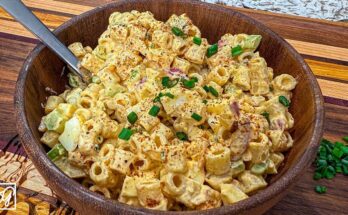Apple Cider Donuts Recipe: If autumn had a signature scent, it would definitely be the warm, comforting aroma of apple cider donuts sizzling in the kitchen. These treats are a fall staple, often found at farmers’ markets and orchards, and beloved for their crisp exteriors, soft and cakey insides, and a sweet-spiced sugar coating that melts in your mouth.
What Makes Apple Cider Donuts So Special?
Apple cider donuts aren’t your average donuts—they carry the soul of fall in every bite. The concentrated apple cider adds a rich, tangy depth that perfectly complements the warm notes of cinnamon, nutmeg, and cloves. Unlike yeast donuts, these are cake donuts, meaning they have a denser texture that pairs beautifully with a hot cup of coffee or fresh cider.
What truly sets them apart is that burst of apple flavor. Reducing the cider intensifies the taste, making the dough rich with autumnal character. Add a sprinkle of cinnamon sugar on the outside, and you’ve got yourself a cozy indulgence that screams sweater weather.
Seasonal Appeal and Popularity
Why are these donuts so popular in fall? It’s all about nostalgia and comfort. Apple cider donuts bring back memories of hayrides, pumpkin patches, and crisp leaves crunching under your boots. They’re tied to traditions—be it Halloween, Thanksgiving, or a simple weekend at the orchard.
And it’s not just nostalgia. Social media has turned these donuts into seasonal celebrities, with foodies and influencers raving about their irresistible charm. Whether you bake them at home or fry them fresh, apple cider donuts are the sweet taste of autumn you’ll crave all year.
Key Ingredients for Apple Cider Donuts
The magic of these donuts lies in using the right ingredients in the right way. Let’s break them down.
Importance of Using Apple Cider Concentrate
Start with real apple cider—not juice. Cider is unfiltered and gives a more intense apple flavor. But don’t pour it straight in the mix! The key is reducing the cider on the stovetop to about half or even a third of its original volume. This concentrates the flavor, making it bolder and richer.
Using reduced apple cider brings a syrupy depth that blends perfectly with the warm spices, enhancing the donut’s natural sweetness and complexity.
Dry and Wet Ingredient Breakdown
Here’s a basic list of what you’ll need:
Dry Ingredients:
- All-purpose flour
- Baking powder and baking soda
- Salt
- Ground cinnamon, nutmeg, and cloves (or pumpkin pie spice)
Wet Ingredients:
- Unsalted butter (melted)
- Eggs
- Brown sugar (adds molasses depth)
- Granulated sugar
- Buttermilk (adds tang and moisture)
- Vanilla extract
- Apple cider (reduced)
Each ingredient plays a role. The flour and leavening agents give structure. The spices add warmth. The sugars balance the tangy cider. Buttermilk keeps things tender, while the butter ensures richness and flavor.
Equipment You’ll Need
Before diving in, make sure your kitchen is armed with the essentials to make the process smooth and stress-free.
Kitchen Tools for Easy Baking
Here’s what you’ll need:
- Mixing bowls
- Whisk and spatula
- Electric mixer (optional but helpful)
- Measuring cups and spoons
- Small saucepan (for reducing cider)
These tools help you prepare the dough efficiently and without lumps. A smooth dough means evenly cooked, soft donuts.
Recommended Donut Pans and Frying Options
You’ve got two paths here: baking or frying.
- For baking: Use a non-stick donut pan. It’s mess-free and healthier. Bake at 350°F (175°C) for 12–14 minutes.
- For frying: A heavy-bottomed pot or Dutch oven works best. Fry in vegetable oil heated to 350°F (175°C) until golden brown (about 1 minute per side).
Fried donuts have a crispier outside, while baked ones are lighter and fluffier. Choose based on your preference!
Step-by-Step Instructions for Making Apple Cider Donuts
Let’s roll up our sleeves and dive into the process. Follow these steps, and you’ll be feasting on homemade donuts in no time.
Step 1: Reducing the Apple Cider
Start by pouring 2 cups of apple cider into a saucepan. Bring it to a boil over medium-high heat, then reduce to a simmer. Let it bubble away until it’s reduced to about ¾ cup. This can take 15–20 minutes. Stir occasionally to prevent scorching.
Let the reduced cider cool before adding it to the dough—it should be warm, not hot, so it doesn’t scramble the eggs.
Step 2: Preparing the Dough
In a large bowl, whisk together:
- 2 ½ cups all-purpose flour
- 1 tsp baking soda
- 1 tsp baking powder
- ½ tsp salt
- 1 tsp cinnamon
- ½ tsp nutmeg
In another bowl, mix:
- ½ cup brown sugar
- ¼ cup granulated sugar
- 2 eggs
- ½ cup buttermilk
- ¼ cup melted butter
- 1 tsp vanilla
- ¾ cup reduced apple cider
Gradually combine the wet and dry mixtures. Mix just until combined. The dough will be thick and sticky—perfect for rolling.
Step 3: Rolling and Cutting the Donuts
Lightly flour a clean surface and roll the dough to about ½-inch thickness. Use a donut cutter or two round cutters (like a glass and bottle cap) to shape your donuts. Re-roll scraps until all dough is used.
Let the cut donuts rest while you heat the oil or preheat the oven.
Step 4: Frying or Baking Your Donuts
Now it’s time for the magic—cooking the donuts! Whether you prefer frying or baking, both methods give delicious results.
For Frying:
- Heat vegetable oil in a deep pan to 350°F (175°C). Use a thermometer to keep the temperature steady—too hot, and the donuts burn; too cool, and they absorb oil.
- Gently place 2–3 donuts into the oil. Don’t overcrowd the pan.
- Fry each side for about 1 minute, or until golden brown. Use a slotted spoon or tongs to flip and remove.
- Transfer donuts to a paper towel-lined tray to drain excess oil.
For Baking:
- Preheat your oven to 350°F (175°C).
- Grease a donut pan and pipe or spoon the batter into each cavity.
- Bake for 12–14 minutes until they spring back when touched.
- Let cool for 5 minutes before removing from the pan.
Both methods result in mouthwatering donuts. Frying gives a classic crispy edge, while baking offers a slightly lighter, more cake-like bite.
Step 5: Coating with Cinnamon Sugar
Don’t skip this step—it’s what gives apple cider donuts their irresistible finish.
In a shallow bowl, mix:
- ½ cup granulated sugar
- 1 tsp cinnamon
- Optional: a pinch of nutmeg for extra warmth
While the donuts are still warm, lightly brush them with melted butter, then roll them in the cinnamon-sugar mix until fully coated.
This coating adds texture and brings all the flavors together. If you’re feeling adventurous, try dipping the tops in a cinnamon glaze or dusting with powdered sugar for a twist.
Tips for Perfect Apple Cider Donuts
Want bakery-quality donuts at home? These tips will make all the difference.
How to Avoid Overmixing
Overmixing the dough leads to tough, chewy donuts instead of soft and tender ones. Mix just until the flour is incorporated. A few lumps are fine—resist the urge to overwork it.
If you’re using a mixer, switch to a spatula once the ingredients start coming together. Gentle handling ensures a fluffy texture.
Best Practices for Frying
- Use a thermometer: It’s your best friend for perfect frying.
- Avoid crowding: Fry in small batches to keep the oil temperature stable.
- Let donuts rest after frying: Drain on paper towels before coating. This keeps them crisp and not soggy.
- Re-use oil carefully: Strain and store it in a jar for the next batch, but don’t use it more than twice for sweets.
Frying can seem intimidating, but with the right tools and timing, it’s a breeze.
Storage and Reheating
Donuts are best fresh, but you can definitely enjoy them later, too.
How Long Do Apple Cider Donuts Last?
Apple cider donuts stay good for about 2–3 days at room temperature. Store them in an airtight container to prevent drying out. You can also refrigerate them for up to 5 days, though the texture may change slightly.
Reheating Tips for Best Flavor
To bring back that just-made magic:
- Microwave for 10–15 seconds for a warm, soft donut.
- Use a toaster oven at 300°F for 5 minutes to get the exterior crisp again.
- Avoid overheating—they’ll dry out fast.
You can also freeze them. Wrap individually in plastic, then store in a freezer bag for up to 2 months. Thaw at room temp, then warm up before eating.
Variations to Try
Want to change things up? Try these fun spins on the classic.
Gluten-Free Version
Swap all-purpose flour with a 1:1 gluten-free flour blend. Add 1 tsp of xanthan gum if your mix doesn’t include it. The donuts will still be moist and flavorful, just with a slightly different crumb.
Apple Cider Donut Holes
No donut cutter? Use a small cookie scoop or shape tiny balls with your hands. Fry or bake as you would regular donuts, just reduce the cook time to about 30–45 seconds per side for frying, or 8–10 minutes for baking.
Donut holes are perfect for parties or snacking. Plus, they’re great for kids!
Common Mistakes and How to Avoid Them
Even seasoned bakers can run into trouble. Here are some common mistakes and how to fix them:
- Using regular apple juice: It’s too mild. Always choose real apple cider and reduce it for depth of flavor.
- Overmixing: Leads to dense, rubbery donuts. Mix gently!
- Skipping the cider reduction: Makes the flavor weak. This step is non-negotiable.
- Oil too hot or too cold: Use a thermometer for perfect fry results.
- Not coating when warm: Sugar won’t stick to cool donuts—coat them right after frying or baking.
Avoiding these missteps ensures bakery-style results every time.
FAQs about Apple Cider Donuts Recipe
1. Can I make these donuts without a fryer?
Absolutely! Just bake them in a donut pan at 350°F for 12–14 minutes. They’ll be slightly lighter but still full of flavor.
2. Can I use store-bought apple cider?
Yes, but make sure it’s real cider, not apple juice. Cider has a deeper, more complex flavor that really shines when reduced.
3. How do I make these donuts ahead of time?
Make and freeze the dough, or bake/fry and freeze the finished donuts. Just warm them up when you’re ready to eat!
4. Can I freeze apple cider donuts?
Definitely. Wrap individually, freeze up to 2 months, and reheat before serving for best texture and flavor.
5. What’s the difference between apple juice and apple cider?
Apple cider is unfiltered and often unpasteurized, with a tangier, fuller apple flavor. Juice is filtered, sweeter, and lacks the depth needed for this recipe.
Conclusion
Apple cider donuts are more than just a fall treat—they’re a bite of comfort and nostalgia. With their cozy spices, bold apple flavor, and sweet cinnamon-sugar finish, they’re the ultimate homemade indulgence. Whether you fry or bake, make them classic or gluten-free, these donuts bring joy to any kitchen.
So the next time you’re craving something warm, delicious, and oh-so-fall, whip up a batch of these apple cider donuts. Your home will smell amazing, and your taste buds will thank you.



